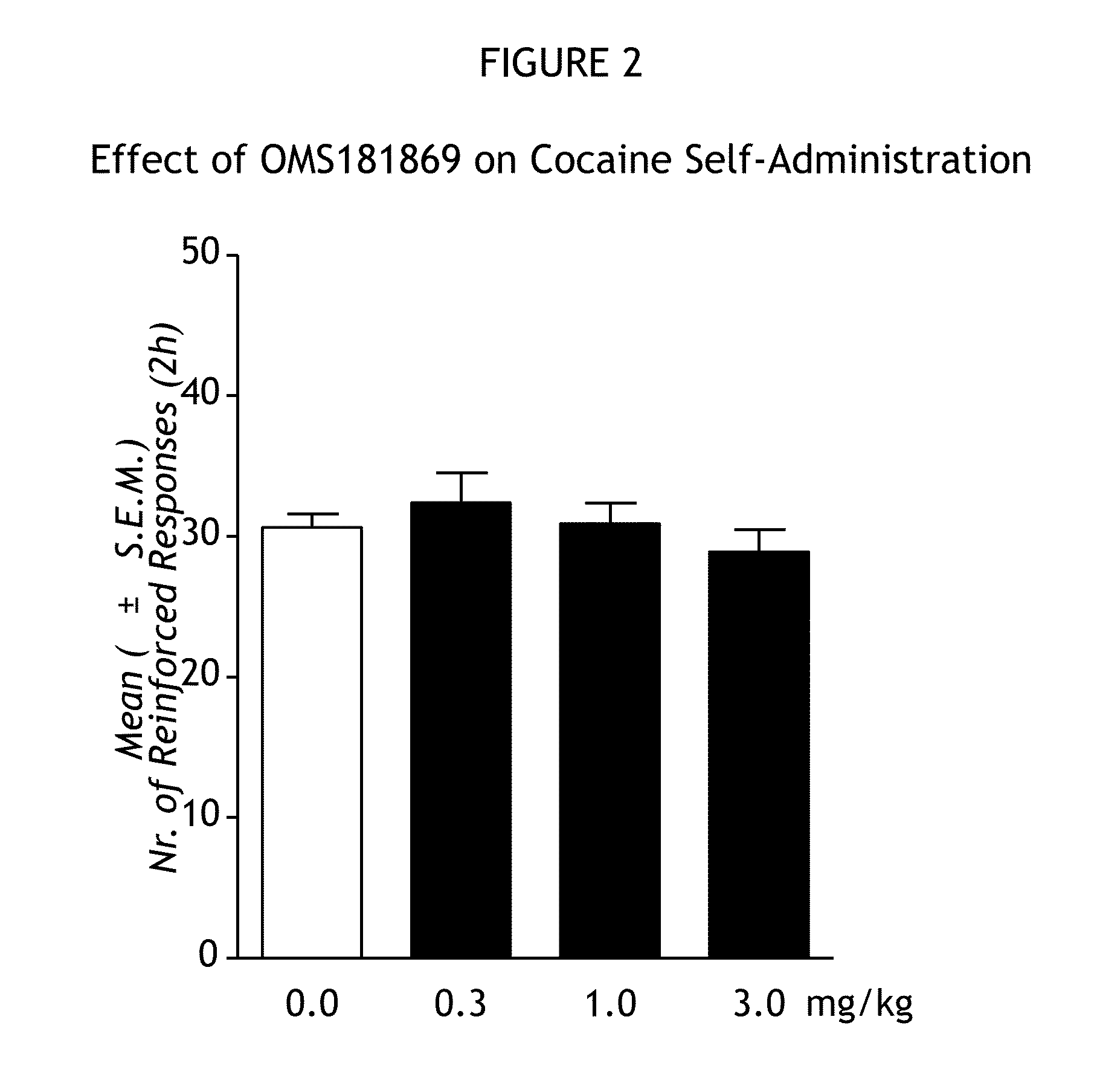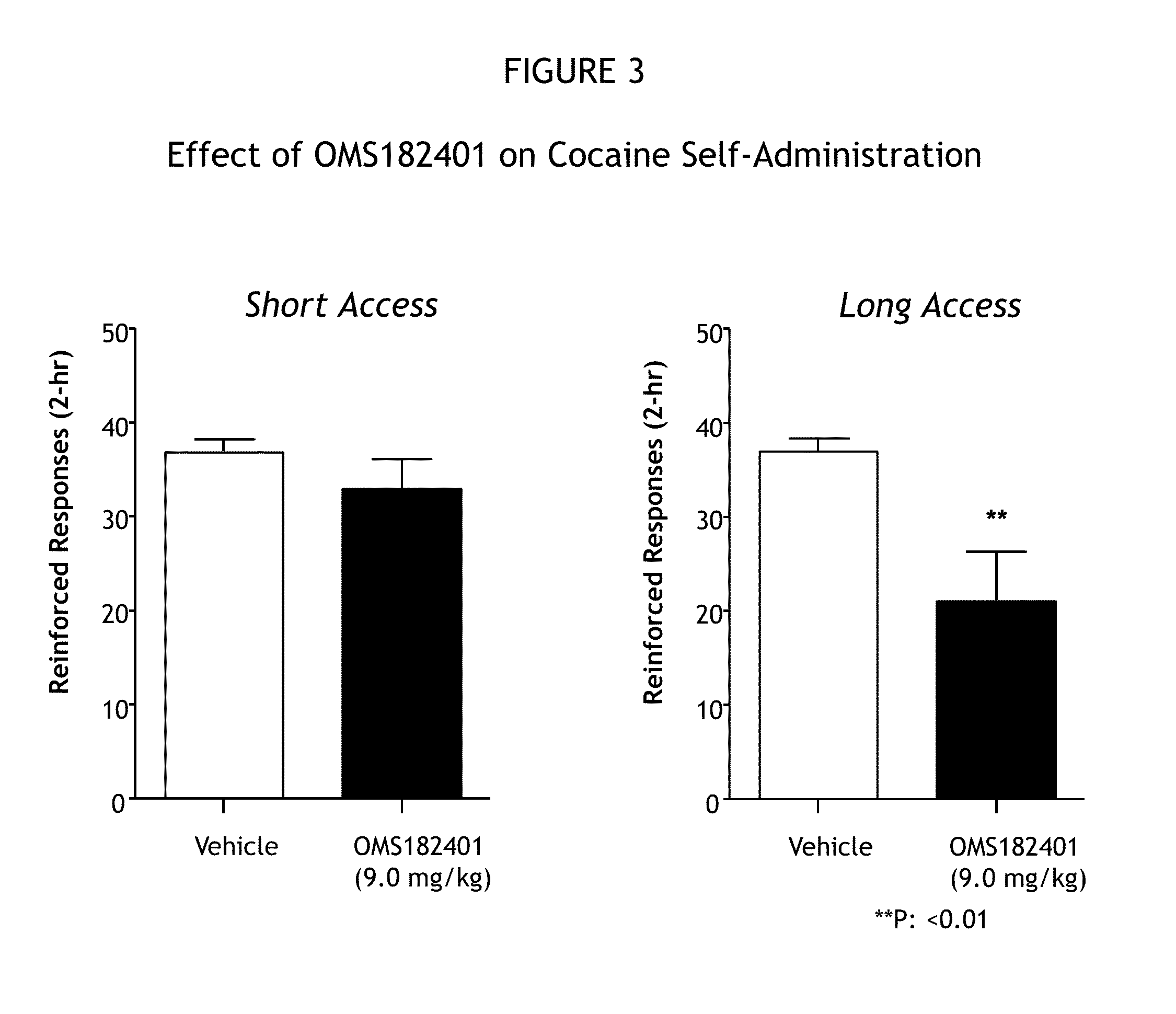Treatment of addiction and impulse-control disorders using PDE7 inhibitors
a technology of phosphodiesterase and inhibitors, applied in the field of prevention and treatment of substance and behavioral addictions using phosphodiesterase 7 (pde7), can solve the problems of alcohol abuse, 1.8 million deaths per year, social problems and adverse consequences, severe mental disorders, etc., and achieve the effect of reducing the motivation of the subj
- Summary
- Abstract
- Description
- Claims
- Application Information
AI Technical Summary
Benefits of technology
Problems solved by technology
Method used
Image
Examples
example 1
PDE7 Inhibition Alleviates Cocaine Addiction
[1355]a. Reduction of Self-Administration of Cocaine
[1356]The ability of PDE7 inhibition to reduce cocaine use by reducing relapse to cocaine addiction and reducing chronic cocaine self-administration was demonstrated in a rat model of cocaine addiction. Cocaine hydrochloride (obtained from the National Institute on Drug Abuse, Bethesda, Md.) was dissolved in sterile physiological saline at a concentration of 0.25 mg / 0.1 mL. Drug or vehicle solution was infused at a volume of 0.1 mL over 4 seconds. Two PDE7 inhibitors in accordance with Formulas 1A (OMS182056) and 1B (OMS181869) herein above and one PDE7 inhibitor in accordance with Formula 6 herein above (OMS182401) were tested for effects on cocaine self-administration. OMS182056 and OMS181869 were given intraperitoneally (i.p.) procedure 12 hours and 1 hour before the beginning of cocaine self-administration. OMS182401 was given intraperitoneally.
[1357]Male Wistar rats weighing between ...
example 2
PDE7 Inhibition Alleviates Nicotine Addiction
[1374]a. Reduction of Self Administration of Nicotine
[1375]The ability of PDE7 inhibition to reduce nicotine use was demonstrated in a rat model of nicotine addiction. Male Wistar rats weighing between 180 and 200 g at the time of arrival in the lab were used. The rats were housed in groups of three in a humidity- and temperature-controlled (22° C.) vivarium on a 12 hour: 12 hour reverse light / dark cycle (on, 17:00; off, 05:00) with ad libitum access to food and water.
[1376]Rats were surgically implanted with jugular catheters and allowed to recover for one week. The animals underwent daily two-hour (short access) or six-hour (long access) training sessions in which every three active lever presses triggered the delivery of 0.03 mg of nicotine. After achieving a stable rate of active lever pressing, the animals were injected IP with vehicle or drug (either OMS182401 or OMS182399, another PDE7 inhibitor in accordance with Formula 6 above) ...
example 3
Reduction of Self Administration of Nicotine Extinction
[1386]The ability of PDE7 inhibition to accelerate nicotine extinction was demonstrated in a rat model of nicotine addiction. Rats were trained to a stable level of nicotine self-administration. The active lever was not associated with any reinforced reward. Prior to the first extinction session, animals were injected with vehicle or OMS182401. The total responses at the active lever during the first hour of the first extinction session were counted. Results are shown in FIG. 20. OMS182401 facilitated nicotine extinction in a statistically significant manner.
[1387]Another study evaluated the effect of OMS182401 on non-reinforced responding on the first day of extinction in rats that had been trained to food pellets to confirm the specificity of the effect of OMS182401 on drugs of abuse. Sixteen male Wistar rats were trained to self administer food pellets for eight days and then were divided into two groups and injected with eit...
PUM
| Property | Measurement | Unit |
|---|---|---|
| molecular weight | aaaaa | aaaaa |
Abstract
Description
Claims
Application Information
 Login to View More
Login to View More - R&D
- Intellectual Property
- Life Sciences
- Materials
- Tech Scout
- Unparalleled Data Quality
- Higher Quality Content
- 60% Fewer Hallucinations
Browse by: Latest US Patents, China's latest patents, Technical Efficacy Thesaurus, Application Domain, Technology Topic, Popular Technical Reports.
© 2025 PatSnap. All rights reserved.Legal|Privacy policy|Modern Slavery Act Transparency Statement|Sitemap|About US| Contact US: help@patsnap.com



